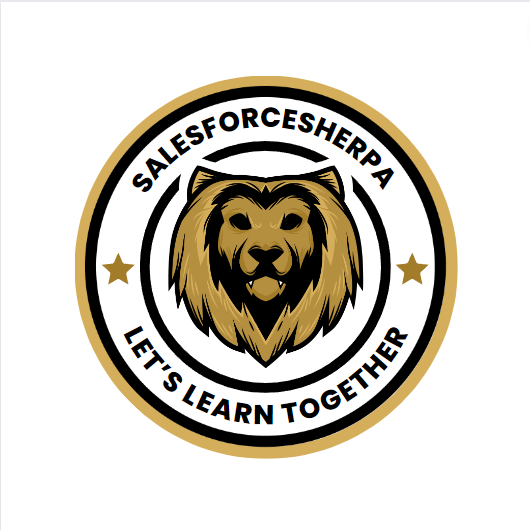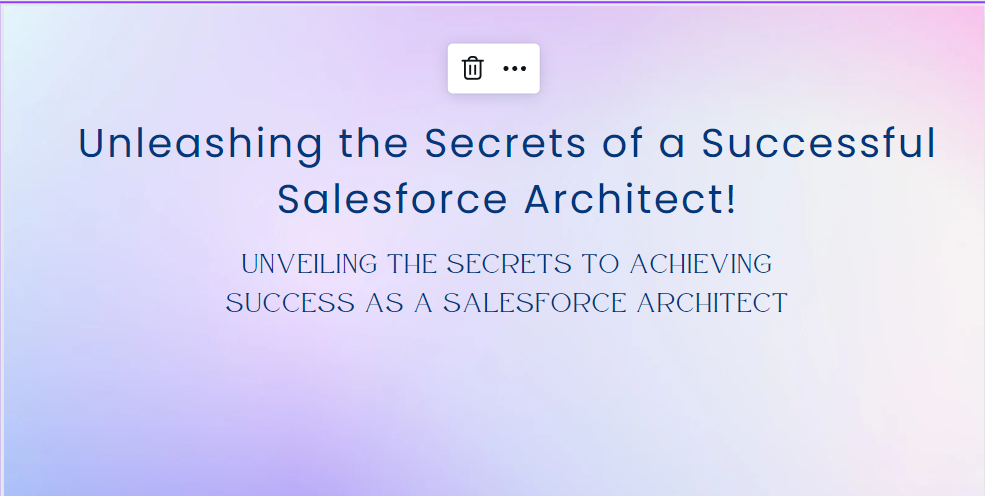Unleashing the Secrets of a Successful Salesforce Architect!
 SalesforceSherpa
SalesforceSherpa
In today's fiercely competitive business landscape, the role of a Salesforce Architect is paramount to the success of any Salesforce implementation. A Salesforce Architect is a skilled professional who plays a pivotal role in analyzing an organization's requirements and translating them into effective Salesforce solutions. This article will delve into the key aspects of becoming a successful Salesforce Architect, including their responsibilities, essential skills, qualifications, and the path to achieving this coveted role.
What is a Salesforce Architect?
A Salesforce Architect is a seasoned expert who acts as a crucial link between technical teams and business stakeholders. Their primary responsibility is to understand and analyze an organization's unique business needs and design scalable, efficient, and sustainable Salesforce solutions that align with the company's objectives and best practices. An effective Salesforce Architect brings together technical expertise, business acumen, and exceptional communication skills to ensure successful project outcomes.
Responsibilities of a Salesforce Architect
Salesforce Architects shoulder a wide range of responsibilities, making their role multifaceted and challenging. Some of their key responsibilities include:
H2: Requirement Gathering and Analysis
Before embarking on any Salesforce project, the architect conducts comprehensive workshops and meetings with stakeholders to gather and analyze their requirements thoroughly. This crucial step sets the foundation for the entire project.
H2: Solution Design and Documentation
Once the requirements are crystal clear, the Salesforce Architect creates a detailed solution blueprint. This includes designing data models, process flows, integration points, and security considerations. The architect also ensures comprehensive documentation of the design to effectively communicate it with the development team.
H2: System Integration
Salesforce often needs to integrate seamlessly with other systems within an organization's tech stack. The architect is responsible for devising integration strategies that ensure smooth data flow and processes across the integrated systems.
H2: Performance Optimization
Efficient performance is a top priority for any Salesforce solution. The architect must optimize the system's performance to ensure quick response times and smooth user experiences, even under heavy user loads.
H2: Security and Compliance
Data security and compliance are of utmost importance in any Salesforce project. The architect must implement robust security measures and ensure that the solution complies with industry standards and data protection regulations.
H2: User Training and Support
Collaborating with end-users is crucial for a successful Salesforce implementation. The architect provides training and ongoing support to ensure that users can effectively utilize the solution and maximize its benefits.
Key Skills and Qualifications
To become a successful Salesforce Architect, several key skills and qualifications are essential:
H2: Technical Proficiency
A Salesforce Architect must possess deep technical knowledge of the Salesforce platform, including its various clouds, integration capabilities, and customization options. Proficiency in programming languages like Apex and Lightning Web Components (LWC) is also crucial.
H2: Business Acumen
Understanding the intricacies of an organization's business processes and objectives is vital for a Salesforce Architect. This helps them design solutions that align perfectly with the company's strategic goals.
H2: Communication Skills
Effective communication is the cornerstone of a successful Salesforce Architect. The ability to articulate complex technical concepts to non-technical stakeholders and vice versa is paramount for project success.
H2: Problem-Solving Ability
Salesforce Architects often encounter complex challenges that require innovative solutions. Strong problem-solving skills are crucial to devising effective and efficient solutions.
H2: Project Management
Managing projects efficiently is essential for delivering Salesforce solutions on time and within budget. Good project management skills help keep projects on track and ensure successful completion.
The Path to Becoming a Salesforce Architect
Becoming a Salesforce Architect is a rewarding journey that requires a combination of education, hands-on experience, and certifications. Here is a typical path to achieving this coveted role:
H2: 1. Educational Background
Start by obtaining a bachelor's degree in computer science, software engineering, or a related field. A strong educational foundation is essential for building technical expertise.
H2: 2. Gain Salesforce Experience
Work as a Salesforce developer or administrator to gain practical experience with the platform. Hands-on experience is invaluable in understanding the intricacies of Salesforce.
H2: 3. Acquire Certifications
Salesforce offers a wide range of certifications for different roles. Aspiring Salesforce Architects should aim to obtain relevant certifications like Salesforce Certified Application Architect or System Architect.
H2: 4. Pursue Advanced Certifications
Advanced certifications like Salesforce Certified Technical Architect showcase expertise and open doors to higher-level opportunities. Pursuing advanced certifications demonstrates a deep understanding of the Salesforce platform.
Understanding Salesforce Architecture
Salesforce follows a multi-tenant architecture, where multiple organizations share the same infrastructure while keeping their data isolated. The Salesforce architecture includes the following key components:
H2: 1. Data Model
The data model defines how data is structured, stored, and accessed within Salesforce. A well-designed data model forms the backbone of a successful Salesforce implementation.
H2: 2. Metadata
Metadata describes the structure of custom objects, fields, workflows, and other configuration elements in Salesforce. Understanding metadata is essential for effective customization and configuration.
H2: 3. Apex and Lightning Web Components (LWC)
Apex is Salesforce's proprietary programming language used for writing custom business logic and controllers. Lightning Web Components (LWC) are modern, reusable UI components used for building engaging user interfaces.
Best Practices for Designing Salesforce Solutions
Designing effective Salesforce solutions requires adherence to best practices and industry standards. Here are some best practices that Salesforce Architects should follow:
H2: 1. Start with a Clean Data Model
A well-organized data model lays a strong foundation for a successful Salesforce implementation. Salesforce Architects should design a data model that reflects the organization's business processes accurately.
H2: 2. Embrace Reusability
Leveraging Salesforce's declarative features and reusable components saves time and effort during development. Reusability also leads to consistent and efficient solutions.
H2: 3. Design for Scalability
Anticipating future growth and designing scalable solutions is critical. A scalable solution can handle increased data volumes and user loads without compromising performance.
H2: 4. Optimize User Experience
Prioritizing user experience is essential for driving user adoption and success. An intuitive and user-friendly interface enhances user satisfaction and productivity.
Integrating AppExchange Apps
AppExchange offers a vast array of pre-built applications that can be integrated into Salesforce. Here's how Salesforce Architects can make the best use of these apps:
H2: 1. Identify Business Needs
Understanding the specific business requirements is key to selecting the right AppExchange apps. Salesforce Architects must work closely with stakeholders to identify their needs and pain points.
H2: 2. Evaluate App Quality
Thoroughly reviewing user reviews, ratings, and vendor credentials helps in selecting high-quality AppExchange apps. Quality apps enhance the overall Salesforce experience.
H2: 3. Plan for Integration
Careful planning and execution of the integration process ensure seamless functioning between the AppExchange app and existing solutions. Proper integration is crucial for a harmonious Salesforce ecosystem.
Managing Data Security and Governance
Data security and governance are of utmost importance in any Salesforce project. Salesforce Architects must take the following measures to ensure data security:
H2: 1. Implement Role-Based Access Control
Restricting access to sensitive data based on user roles and responsibilities helps prevent unauthorized access.
H2: 2. Monitor Data Usage
Regularly monitoring data access and usage patterns can help identify potential security risks or anomalies in data usage.
H2: 3. Comply with Data Regulations
Staying updated with data regulations and ensuring compliance with data protection laws is crucial for data security and privacy.
Performance Optimization Techniques
To ensure optimal performance, Salesforce Architects can employ the following techniques:
H2: 1. Use Efficient Data Queries
Optimizing data queries helps reduce response times and minimizes the strain on the system.
H2: 2. Leverage Caching
Implementing caching mechanisms helps store frequently accessed data and reduces the need for frequent database queries.
H2: 3. Optimize Code Execution
Reviewing and optimizing Apex code can lead to improved performance and prevent governor limit breaches.
Working with Stakeholders and Teams
Collaboration and effective communication are pivotal for a successful Salesforce project. Salesforce Architects must take the following steps:
H2: 1. Foster Open Communication
Encouraging open communication between stakeholders and team members fosters transparency and promotes a positive work environment.
H2: 2. Engage Business Leaders
Involving business leaders in the decision-making process ensures that solutions align with the organization's strategic goals.
H2: 3. Empower the Team
Empowering team members and encouraging their creativity leads to innovative solutions and successful project outcomes.
Conclusion
Becoming a successful Salesforce Architect requires a combination of technical expertise, business acumen, effective communication, and problem-solving skills. Aspiring architects should pursue relevant certifications and gain hands-on experience to hone their skills. Following best practices, staying updated with Salesforce updates, and embracing continuous learning are essential for excelling in this role.
The role of a Salesforce Architect is instrumental in driving organizational success through efficient and scalable Salesforce solutions. By understanding the secrets of a successful Salesforce Architect, organizations can unlock the full potential of the Salesforce platform and elevate their business to new heights.
FAQs (Frequently Asked Questions)
Q: What educational background is required to become a Salesforce Architect?
A: Aspiring Salesforce Architects should have a bachelor's degree in computer science, software engineering, or a related field.
Q: What are the primary responsibilities of a Salesforce Architect?
A: Salesforce Architects are responsible for requirement gathering, solution design, system integration, performance optimization, data security, and user training, among other duties.
Q: How can I become a Salesforce Architect?
A: To become a Salesforce Architect, gain hands-on experience, pursue relevant certifications, and continuously update your skills.
Q: What is the importance of user experience in Salesforce solutions?
A: Prioritizing user experience ensures higher user adoption rates and increases productivity.
Q: How can Salesforce Architects ensure data security?
A: Salesforce Architects can implement role-based access control, monitor data usage, and comply with data regulations to ensure data security and governance.
Subscribe to my newsletter
Read articles from SalesforceSherpa directly inside your inbox. Subscribe to the newsletter, and don't miss out.
Written by
